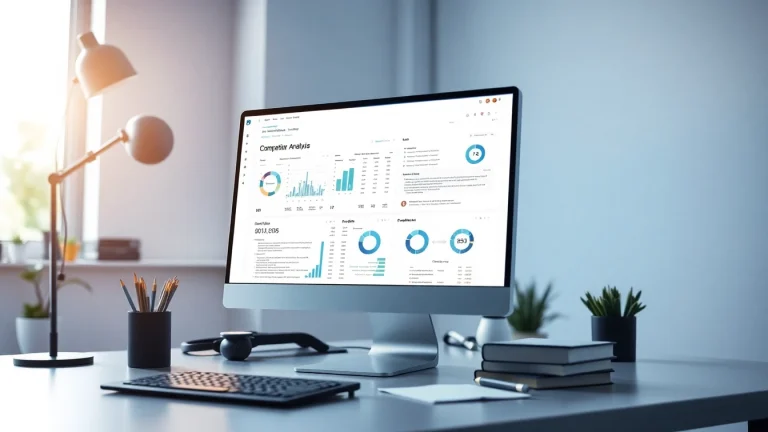
Mastering Competitor Analysis: Strategies to Outperform Your Rivals
Understanding Competitor Analysis
What is Competitor Analysis?
A competitor analysis, also referred to as competitive analysis or competition analysis, is fundamental to any successful business strategy. It is the process of examining similar brands within your industry to gain insights into their offerings, branding, sales, and marketing strategies. This analysis equips organizations to evaluate their position relative to competitors and uncover best practices that can inform their own tactics.
In essence, a thorough competitor analysis enables a business to identify its strengths and weaknesses by directly comparing them against their direct and indirect competitors. By keeping a careful watch over the competition, businesses can anticipate market trends, innovate, and ultimately achieve a competitive edge.
The Importance of Analyzing Competitors
Understanding competitors is critical for several reasons:
- Market Positioning: An analysis allows companies to understand where they stand in the marketplace. This insight is essential for positioning products and services effectively.
- Finding Gaps: It helps businesses identify market gaps or underserved needs that they can exploit.
- Improving Strategies: Analyzing competitor strategies helps companies learn from others’ successes and failures, enabling them to refine their marketing approaches and value propositions.
- Enhancing Customer Insights: By understanding competitor offerings, businesses can gain insights into customer preferences, influencing product development and marketing strategies aimed at attracting and retaining clients.
- Proactive Planning: Effective competitor analysis facilitates better forecasting and proactive adjustments to tactics in order to meet evolving market demands.
Key Metrics to Track
When conducting a competitor analysis, it’s crucial to focus on key metrics that reveal insights into competitors’ performance and strategies:
- Market Share: Assess the percentage of an industry or market that a competitor controls compared to you.
- Product Pricing: Monitor how competitors price their products and services, including any promotional strategies.
- Customer Reviews and Satisfaction: Analyze customer feedback and reviews to gauge competitors’ strengths and areas for improvement.
- Social Media Engagement: Investigate how competitors engage audiences on social media platforms, evaluating their brand affinity and reach.
- Website Traffic and SEO Performance: Use tools to assess web traffic, analyze keyword rankings, and observe their SEO strategies.
- Sales Performance: Track competitors’ sales figures as much as possible, including estimates of revenue and growth rate.
Steps to Conduct an Effective Competitor Analysis
Identifying Your Competitors
Identifying competitors is the first step in conducting a thorough competitor analysis and involves more than just a basic search of local businesses:
- Direct Competitors: These are businesses selling similar products and services to the same geographical or demographic market.
- Indirect Competitors: These include alternatives that customers might choose over your offerings, even if they are not directly in your niche.
- Future Entrants: Consider potential new entrants in your market that could disrupt business. Analyze their unique selling propositions and business models.
- Use Tools: Utilize tools like Google Trends, SimilarWeb, or social listening platforms to discover and identify competitors in your niche.
Gathering and Analyzing Data
Data collection is fundamental to understanding competitors deeply. Here are several sources of data that should be gathered:
- Website Analysis: Review competitors’ websites to analyze user experience, design, content, and call-to-action effectiveness.
- Content Strategy: Evaluate the quality, frequency, and type of content competitors publish. Use tools like BuzzSumo to find popular topics and formats.
- SEO Performance: Employ tools like SEMrush or Ahrefs to analyze competitors’ backlink strategies and keyword rankings.
- Financial Reports: If your competitors are publicly-listed companies, review their financial reports for insights into their sales strategy and viability.
- Customer Engagement: Monitor how competitors interact with customers through reviews, testimonials, and social media conversations.
Benchmarking Against Competitors
Once you have gathered the relevant data, the next step is to benchmark against your competitors. This can be conducted in the following ways:
- SWOT Analysis: Conduct a SWOT analysis (Strengths, Weaknesses, Opportunities, and Threats) for both your business and your primary competitors to visualize and compare key advantages and challenges.
- Performance Metrics: Use the key metrics identified earlier to evaluate how well your competitors are performing against key indicators and compare them with your performance.
- Trend Observations: Identify any emerging trends or technologies that your competitors are leveraging effectively for their benefit.
- Competitor Positioning Map: Create a positioning map to visualize where you and your competitors sit based on metrics like price and quality or service.
Tools for Effective Competitor Analysis
Top Competitor Analysis Software Options
In today’s technology-driven market, various tools can facilitate competitor analysis. Below are some of the top competitor analysis software:
- SEMrush: A comprehensive tool for digital marketing that allows you to track competitors’ keywords and backlink profiles.
- Ahrefs: Excellent for SEO performance; it provides insights into competitive backlink strategies and search rankings.
- Similarweb: Offers a detailed analysis of website traffic and engagement metrics, allowing benchmarking against competitors.
- BuzzSumo: Useful for content marketing analysis by tracking what content performs best with competitors.
- Sprout Social: Best known for social media management, it facilitates the monitoring of competitors’ brand sentiment and interaction metrics.
Leveraging Social Media for Insights
Social media platforms are gold mines for competitive insights. Here’s how to effectively leverage them:
- Monitoring Engagement: Keep track of competitors’ social media engagement to see how they respond to followers and manage their brand image.
- Content Analysis: Explore the type of content that generates the most engagement and shares. This will help you understand what resonates with the audience.
- Ad Spending: Use ad transparency tools available on social media sites like Facebook to evaluate how much competitors are spending on targeted advertising.
- Audience Feedback: Analyze customer comments and reactions to competitors’ posts, revealing valuable insights into their strengths and weaknesses.
Integrating SEO Tools into Your Analysis
SEO analysis is a crucial component of competitor analysis. Leveraging SEO tools can help you gain insights into competitors’ online visibility, as highlighted below:
- Keyword Research: Use tools like Google Keyword Planner to discover which keywords your competitors rank for and how you can target similar queries.
- Content Structure: Evaluate the structure and depth of your competitors’ web content using tools like Screaming Frog SEO Spider to identify optimization opportunities.
- Traffic Sources: Analyzing where competitors receive their traffic from – organic search, paid ads, or referrals, can inform strategies and help allocate marketing budgets wisely.
- Technical SEO: Review competitors’ technical SEO elements, including loading speeds, mobile responsiveness, and security protocols to enhance your own site’s performance.
Common Challenges in Competitor Analysis
Overcoming Data Overload
One of the most significant challenges in competitor analysis is dealing with an overwhelming amount of data. Here’s how to streamline it:
- Set Clear Objectives: Begin with defined goals. Know what you want to learn from the analysis, whether it pertains to market position, pricing strategies, or customer satisfaction.
- Focus on Key Metrics: Avoid drowning in data by concentrating on only the most relevant metrics essential to your objectives.
- Use Visualization Tools: Employ data visualization tools to represent insights clearly and concisely, making it easier to derive actionable insights.
Dealing with Rapid Market Changes
Markets are dynamic; hence, strategies must adapt accordingly. Consider these steps to keep up:
- Regular Updates: Establish a schedule to conduct regular competitor analysis to account for changes in the competitive landscape.
- Scenario Planning: Develop contingency strategies for when shifts occur in market demand or competitor actions.
- Feedback Loops: Create mechanisms for continuous feedback and learning, both from market trends and customer insights, to remain agile.
Ensuring Accurate Comparisons
Inaccurate comparisons can lead to misguided strategies. Here’s how to ensure accuracy:
- Standardize Metrics: Use consistent metrics across the board. Make sure everyone analyzes the same data points to allow for valid comparisons.
- Contextual Analysis: Consider the context behind competitors’ actions. Factors such as market conditions or demographic shifts can influence performance differently.
- Review and Adjust: Regularly review your methodologies and assumptions to refine the analysis process and enhance reliability.
Applying Your Competitor Analysis Findings
Strategizing Based on Insights
Once you have collected and analyzed your competitors, it’s time to apply your findings strategically:
- Formulate Strategies: Use the insights to develop actionable business strategies geared towards enhancing your market position.
- Innovate: Identify areas where you can innovate or differentiate your offerings by learning what works well and what doesn’t for competitors.
- Product Development: Let the findings guide product enhancements or new developments based on gaps seen within competitors’ offerings.
Refining Your Marketing Approach
Insights should refine your marketing tactics:
- Target Segmentation: Use competitor insights to refine audience segmentation and target messaging more effectively.
- Content Strategy: Adapt your content marketing strategy to cover subjects and formats that competitors have successfully engaged their audiences with.
- Advertising Strategies: Assess and improve upon the efficiency of your paid media campaigns by taking cues from your competitors’ successful ads.
Measuring Success Over Time
Lastly, it’s crucial to track the results of your strategic initiatives:
- Establish KPIs: Set key performance indicators to measure the effectiveness of changes made based on competitor analysis findings.
- Regular Review: Periodically review competitive standings. Adjust strategies as needed based on ongoing market trends and shifting consumer behaviors.
- Feedback Mechanisms: Use customer feedback to assess the effectiveness of your responses to competitive movements and insights.


